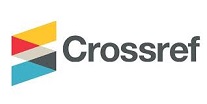Dampak Perbedaan Varietas Terhadap Morfofisiologis Kedelai Tercekam Kekeringan
Abstract
Soybean production in Indonesia has not shown a satisfactory trend, compounded by drought problems that adversely affect plant growth and metabolism. One of the various solutions offered is the use of drought-resistant/tolerant soybean varieties. This study aims to examine how drought-resistant/tolerant varieties differ from drought-susceptible varieties in their morphophysiological response to drought. The study was conducted in a plastic house in Aras Kabu Village, Beringin Subdistrict, Deli Serdang Regency, North Sumatra, using a randomised block design with two factors and three replicates. The first factor was soil moisture conditions, consisting of 80% field capacity (FC) and 40% FC. The second factor was the testing of the Grobogan and Dering varieties. The observation parameters consisted of the number of leaves and leaf K uptake. The results showed that there was a significant interaction between the use of varieties and drought conditions, where the Dering variety significantly reduced the number of leaves, while the Grobogan variety, which is susceptible to drought, increased leaf K uptake to survive.
Keywords: soybean, drought, stress, varieties
Full Text:
PDFReferences
Anjum, S.A., X.Y. Xie., L.C.Wang., M.F. Salem., C. Man., & W. Lei. (2011). Morphological,Physiological, and Biochemical Responses of Plants to Drought Stress. African J. ofAgric. Res. 6(9): 2026 – 2032.
Asyura AG, L. (2021). Peran antioksidan dalam mengatasi cekaman kekeringan pada tanaman kedelai (Glycine max (L.) Merril). Fruitset Sains : Jurnal Pertanian Agroteknologi, 10(1), 06–15. https://doi.org/10.35335/fruitset.v10i1.1836.
Aziez, A. F., Supriyadi, T., Dewi, T. S. K., & Saputra, A. F. (2021). Analisis pertumbuhan kedelai varietas grobogan pada cekaman kekeringan. Jurnal Ilmiah Agrineca, 21(1), 25–33. https://doi.org/10.36728/afp.v21i1.1335.
Balai Penelitian Aneka Kacang dan Umbi. (2018). Tahun 2018 Tahun Kedelai. Balai Penelitian Aneka Kacang dan Umbi. Malang: Balitkabi.
Bhardwaj, J., & S.K. Yadav. (2012). Comparative Study on Biochemical Parameters and Antioxidant Enzymes in a Drought Tolerance and a Sensitive Variety of Horsegram(Macrotyloma uniflorum) Under Drought Stress. American J. Of Plant Physiol. 7(1):17- 29.
Fahri, R. (2021). Pengaruh Pemberian Kalium Terhadap Pertumbuhan Dan Produksi Dua Varietas Kedelai (Glycine Max (L.) Merril) Pada Kondisi Cekaman Kekeringan. Tesis. Universitas Sumatera Utara. Medan.
Heriyanto, N., Rogomulyo, R., & Indradewa, D. (2019). Pengaruh Cekaman Kekeringan Terhadap Hasil dan Komponen Hasil Lima Kultivar Kedelai (Glycine max L.). Vegetalika. 2019. 8(4):227-236.
Lumbanraja, P. (2018). Pengaruh Pemberian Pupuk Kandang Sapi dan Jenis Mulsa Terhadap Kapasitas Pegang Air Tanah dan Pertumbuhan Tanaman Kedelai (Glycine max L.) Var. Willis pada Tanah Ultisol Simalingkar. Jurnal Ilmiah Pendidikan Tinggi (JURIDIKTI)- PROPSU-Medan. ISSN: 1979 – 9640; Volume. 5, No. 2, Agustus 2012, Hal. 58 – 72.
Maleki, A., A. Naderi, R. Naseri, A. Fathi, S. Bahamin & R. Maleki. (2013). Physiological performance of soybean cultivars under drought stress. Bull. Env. Pharmacol. Life Sci. 2(6): 38-44.
Montgomery, D.C. (2001). Introduction to Statistical Quality Control, 4 th edition. John Wiley & Sons,Inc.,New York:Wiley.
Rosawanti, P., Ghulamahdi, M., dan Khumaida, N. 2015. Respon Anatomi dan Fisiologi Akar Kedelai terhadap Cekaman Kekeringan. J. Agron. Indonesia 43 (3) : 186 - 192 (2015).
Sacita, A.S. (2016). Respon Tanaman Kedelai (Glycine Max L.) terhadapCekaman Kekeringan pada FaseVegetatif dan Generatif. Institut Pertanian Bogor, Bogor.Hal5.
Salsabila, Budiyanto, S., dan Rosyida. 2024. Respons Pertumbuhan dan Hasil Tanaman Kedelai (Glycine max (L.) Merril) Akibat Cekaman Kekeringan dan Pemberian Konsentrasi Asam Salisilat. Jurnal AGRO 11(1), Hal. 59-74.
Sharifa, Muriefah A. 2015. Effects of Paclobutrazolon Growthand Physiological Attributesof Soybean (Glycinemax) Plants Grown Under Water Stress Conditions. Int. J. Adv. Res. Biol.Sci. 2(7): (2015): 81–93.
Siregar, S. R., Zuraida, & Zuyasna. (2017). Pengaruh kadar air kapasitas lapang terhadap pertumbuhan beberapa genotipe m3 kedelai (Glycine max L. Merr). Journal Floratek, 12(1), 10–20.
Suhartina, Purwantoro, N. Nugrahaeni, & A. Taufiq. (2014). Stabilitas Hasil Galur Kedelai Toleran Cekaman Kekeringan. Penelitian Pertanian Tanaman Pangan 33(1): 54-60.
Suryanti, S., Indradewa, D., Sudira, P., & Widada, J. (2015). Kebutuhan Air, Efisiensi Penggunaan Air dan Ketahanan Kekeringan Kultivar Kedelai. AGRITECH, Vol. 35, No. 1. Hal. 114-120.
Wahono E., Izzati, M., & Parman, S. (2018). Interaksi antara Tingkat Ketersediaan Air dan Varietas terhadap Kandungan Prolin serta Pertumbuhan Tanaman Kedelai (Glycine max L. Merr). Buletin Anatomi dan Fisiologi. Volume 3 Nomor 1 Februari 2018. Hal. 11-19.
Yusuf, F., Hadie, J., & Yusran, M.F.H. (2017). Respon Tanaman Kedelai terhadap Serapan Hara NPK Pupuk Daun yang diberikan Melalui Akar dan Daun pada Tanah Gambut dan Podsolik.Jurnal Daun, Vol. 4 No. 1, Juni 2017 : 17–28.
Yusuf, F., Hadie, J., & Yusran, M.F.H. (2017). Respon Tanaman Kedelai terhadap Serapan Hara NPK Pupuk Daun yang diberikan Melalui Akar dan Daun pada Tanah Gambut dan Podsolik.Jurnal Daun, Vol. 4 No. 1, Juni 2017 : 17–28.
DOI: https://doi.org/10.36987/agroplasma.v12i2.8086
Refbacks
- There are currently no refbacks.
Jurnal Agroplasma
All publications by Jurnal Agroplasma [p-ISSN: 2303-2944] [E-ISSN:2715-033X] is licensed under a Creative Commons Attribution-NonCommercial 4.0 International License.













